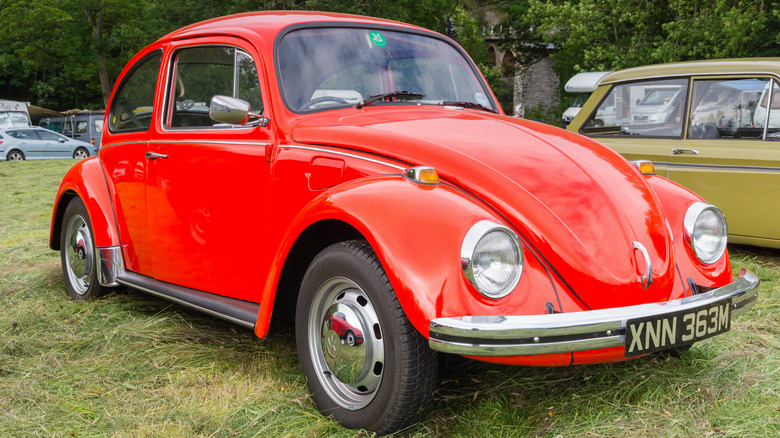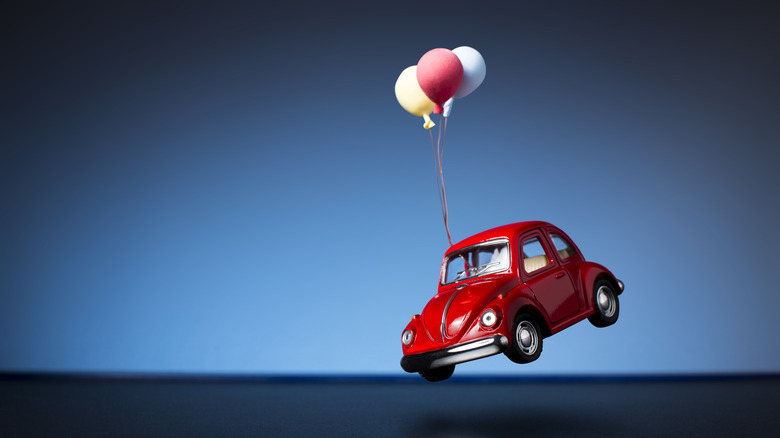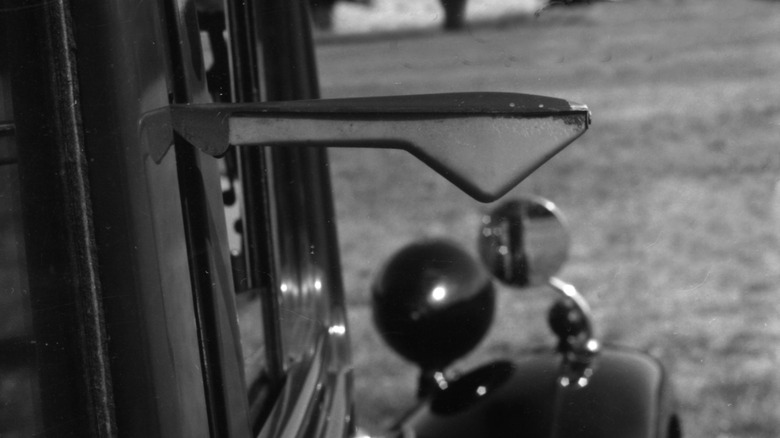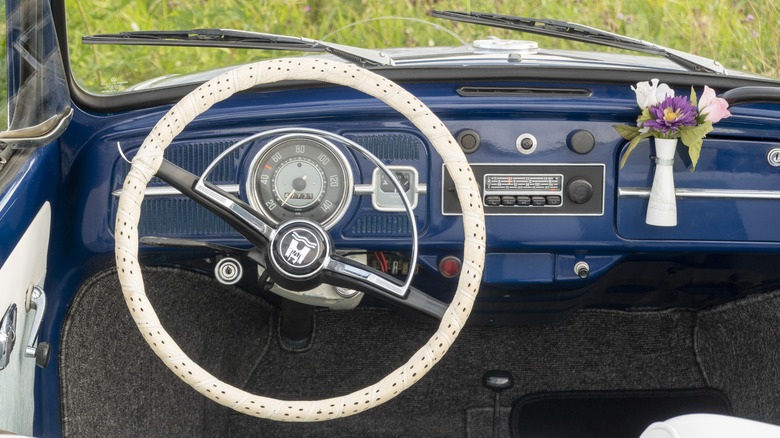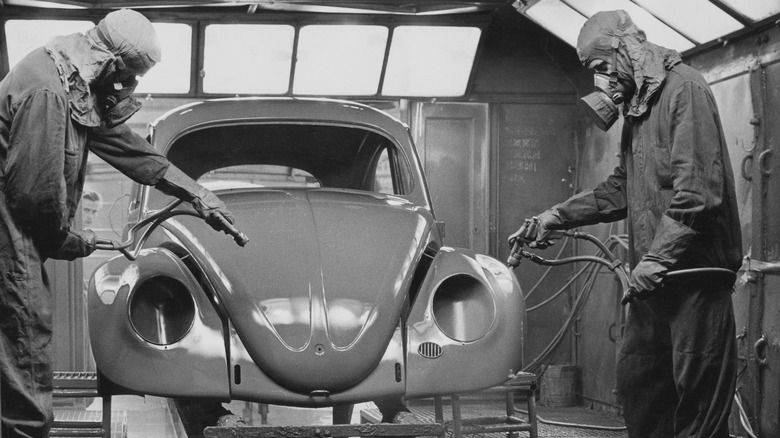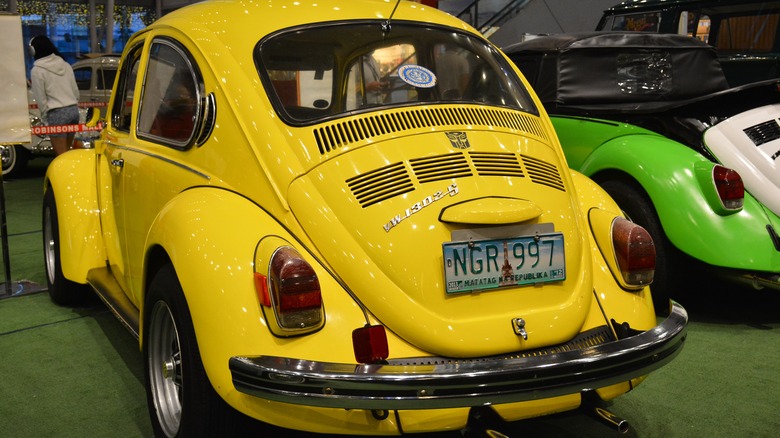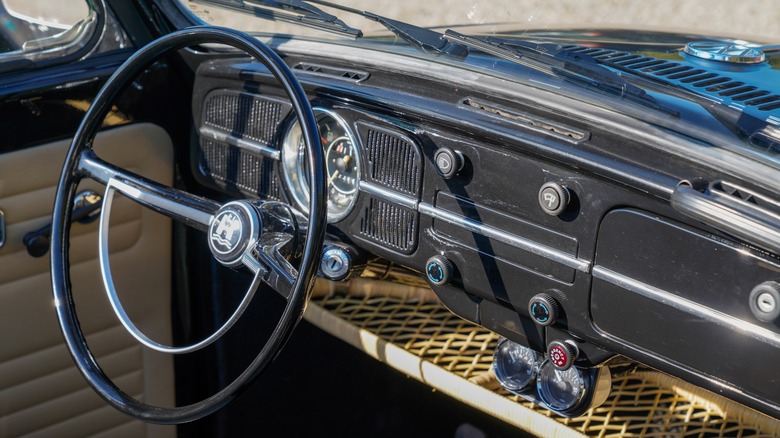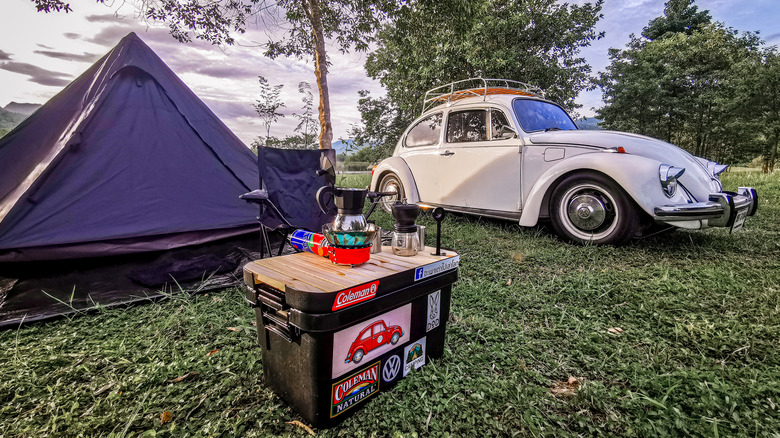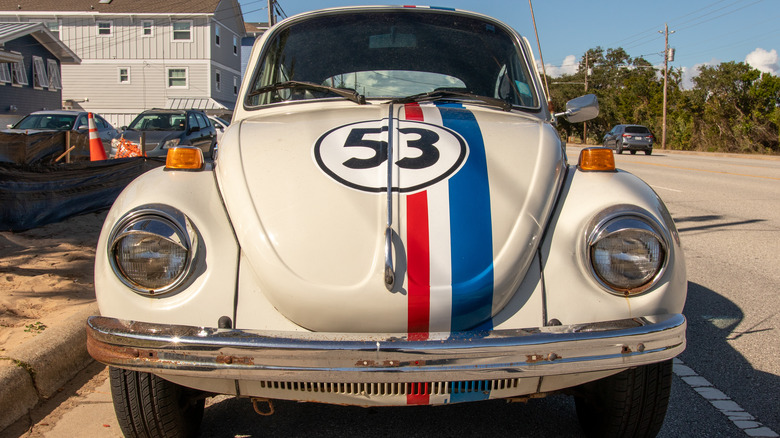8 Of The Coolest And Most Unique Features Of The Volkswagen Beetle
The Volkswagen Beetle may be small in stature, but it's an iconic vehicle that has captured the hearts of millions and held onto them for generations. The story of the Beetle began in 1934 when Adolf Hitler commissioned the design of an affordable yet practical car for the German people. The task was assigned to automotive engineer Ferdinand Porsche, founder of the luxury brand that bears his name.
The round, bubbly shape of the Beetle — which so many have come to know and love — made it an easily recognizable car once it entered the international market. Over the years it has seen various upgrades, design changes, and ultimately its demise when the VW Beetle was discontinued in the 1970s, but the legacy of this little car remains strong.
The Beetle became a global icon that represents individuality, and in the 1960s, it also became a beloved symbol of the counterculture movement. The car has certainly had ups and downs throughout the years in terms of sales but has always managed to make a comeback with special editions and nostalgic reimaginations and a remarkably loyal fan base. As far as uniqueness goes, the Beetle already surpasses most other automobiles just with its shape and size alone. However, the quirky design choices didn't stop there. The Volkswagen Beetle has a history of some truly unique features that make it even more loveable — here are eight of the most unique.
The Volkswagen Beetle could float
Among the most unique features of the classic Volkswagen Beetle is its ability to float. While it's not recommended to test this attribute, it certainly sets the Bug apart from other vehicles. The car's buoyancy is primarily due to its design features and clever engineering. Thanks to its lightweight construction, and air-sealed body panels, the VW Bug has an easier time remaining on the surface of the water than most vehicles. While these qualities won't keep the vehicle afloat forever, they will allow the Beetle to remain on top of the water for at least a short period of time.
The floating capability of the Volkswagen Beetle has often fascinated owners, enthusiasts, and those wishing to conduct experiments, intentionally testing the little car's buoyancy. One experiment claimed that the Bug could float for up to 42 minutes. The floating feature may not have been entirely intentional when the vehicle was initially designed. However, it made its way into a well-known piece of Volkswagen's identity, charm, and marketing tactics. It's also a feature that could really come in handy if one finds themselves in a bit of a watery situation.
Semaphore turn signals
Prior to the tail-light turn signals that fill today's traffic, there were a few different designs that hit the market. The pre-1960 Volkswagen Beetle came equipped with semaphores, a unique way for the driver to let those around know which way they were turning.
Semaphores are different from other traditional turn signals in several ways. Rather than being installed on the rear of the Bug, semaphores are attached to the door pillars of the car. When activated, the semaphore lifts up from the side of the car and lights up on the side the driver intends to turn. The retro, pop-out function of semaphores is an appropriately eye-catching feature on these older Volkswagen models and a testament to just how stylish Beetles have been throughout their history.
The semaphore turn signal was a popular choice for pre-1960 vehicles, however, any older model vehicles on the road today have likely been upgraded to more modern turn signals to fit more modern driving requirements. Nevertheless, the semaphore is definitely one of the more remarkable attributes of the early Volkswagen Beetle.
A flower vase dash attachment
While the Volkswagen Beetle is already adored for its unique bubble design, it's the addition of the "blumenvase," or "bud vase," that adds just the right amount of whimsy to make an already stand-out vehicle even cooler. The vase hit the market in the United States in the 1950s, and it stood out with designs from German porcelain manufacturers. It could be placed in several locations around the car and gave the car owner another way to make their car unique.
Flower vases in cars weren't always such a novelty item. As early as 1895, flower vases were kept in cars so that the added floral scents would hopefully work hard and cover up any other unpleasant smells that may be in or around the automobile. What was once a rather pleasant way of trying to mask a few unpleasantries was transformed by the designers of the Bug into a simple and memorable customization option.
These small flower vases were included as an option in many of Beetle's designs all the way up until 2011, when they were done away with for good. Older model bugs on the road may still be driving around with some pretty petals peeking out from their dash, though.
The Beetle's low price point
There are a lot of attributes that made the Volkswagen Beetle a favorite among consumers, but perhaps the most practical one was the car's low price point. The idea of owning a versatile, trendy vehicle without breaking the bank helped make the car incredibly popular.
In 1937, Volkswagen was founded, although it was initially called Volkswagenwerk, which translates to "the people's car company." The company aimed to put out a vehicle that would not only be reliable for all but affordable for all. With accessibility being at the forefront of the design, the final product was much less expensive than other vehicles of the time.
The affordability of the Beetle made car ownership a possibility for many who had previously been unable to afford a car, especially after the vehicle entered the international market. It became a symbol of economic mobility and freedom, allowing more people to travel conveniently and independently. The affordability of the car didn't get in the way of its quality either, as the Bug was renowned for its longevity and reliability. It really was the people's car.
Rear-window variants
When the Beetle was first designed, its rear window was smaller and more simplistic, although it was an integral part of its eye-catching design. This was the design of choice until the Beetle became available in the United States in 1949. When this happened, the VW's design was altered and the oval shape of the rear window was split down the middle, adding to the car's unique appearance.
The split window design was produced until 1953, when it was transformed yet again. This time it was removed in favor of one larger oval window design. The larger oval window allowed for better visibility for the driver and more of a modern look for the Beetle.
As the Beetle's popularity grew, so did the innovation behind it. Each new model was released with the intent to propel the little car forward, attract new customers, and retain current ones. By keeping the design unique and everchanging, the manufacturers of the Bug created a novelty that would last generations.
A gas heater
There's a long list of features on the Volkswagen Beetle that allowed it to grow in popularity and find its way into the hearts of millions. However, along with all that good came one or two additions that even the most passionate consumers were apprehensive about. The Volkswagen's gas heater was one of these additions.
The heating system in the Beetle was done in a way that wasn't the most efficient, safe, or ideal for those riding in the car. A heat exchanger built into the car's exhaust system allowed hot air to be blown into the vehicle. Volkswagen did offer an alternative to this — a gas-powered heater that would blast hot air throughout the car and warm it up.
Not many car buyers loved the idea of a gas-powered heater running in their vehicle, possibly for one flammable reason or another. Even though the heater was technically a safe option for VW owners, it was never a popular feature.
A dash-mounted coffee maker
Arguably the most unique feature in Volkswagen Beetle history is the Hertella Kaffeemachine. A dash-mounted coffee maker. This VW accessory is so rare that hardly any are around today as evidence these caffeine-providing machines ever existed at all. This dash-mounted café on the go didn't require much power as it simply plugged into the car's cigarette lighter and began warming up to the appropriate brewing temperature.
There were two porcelain cups included that featured metal bottoms to magnetically hold them to the coffee maker. Those who had their own Hertella Kaffeemachine back in its height of popularity would have paid a hefty price tag for a coffee brewing car accessory, at what today would be around $136.
While coffee makers in cars aren't really a popular addition nowadays — and weren't necessarily back when they were an option on the Beetle, either — the novelty of a cup of joe on the go will never wear off.
Round headlights
Even the most outlandish, highly sought-after Volkswagen Beetle accessories don't compare to the overall look of the car. The aesthetic of the Beetle is a huge part of why it became so popular and stayed that way for decades. The unique appearance of its curved frame made it stand out amongst other vehicles. The bubbly look went all the way down to the details of the car as well – even the headlights were completely round.
The round headlights added something to the car that was charismatic and added so much personality that in 1968 Disney released "The Love Bug," a movie featuring an anthropomorphic Volkswagen Beetle named Herbie. Much of Herbie's personality was highlighted through his round headlights. The minor details in the design of the Beetle are what became major details to the enthusiasts and admirers who have long kept a soft spot in their hearts and memories for this bubbly little people's car.
